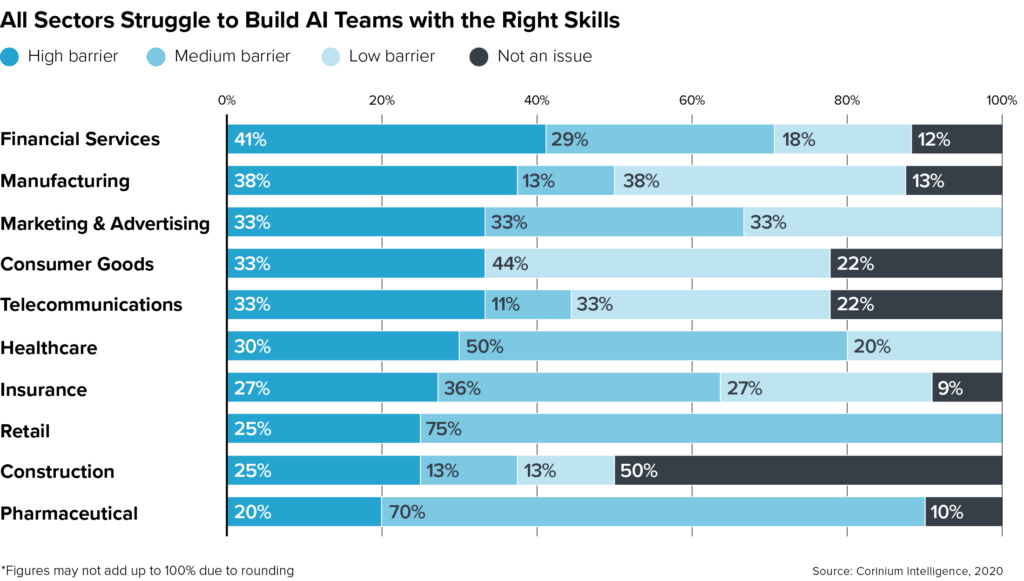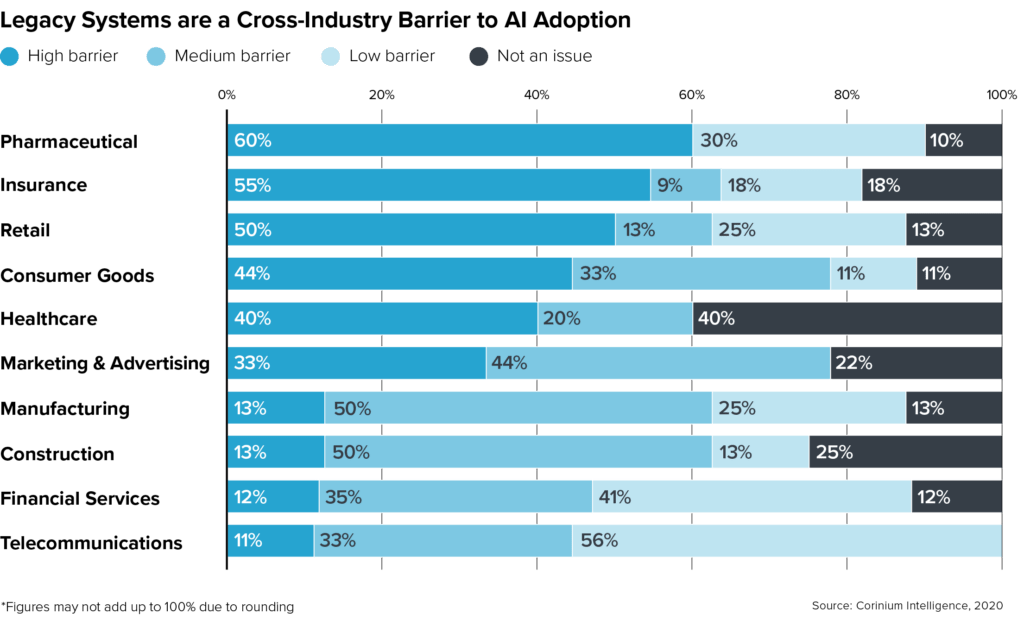The ‘COVID-19 Effect’ on Enterprise AI Adoption

As the pandemic continues to put a strain on many enterprises, demand for data, AI and digital tools is soaring
With COVID-19 continuing to disrupt in-person business transactions, business leaders have quickly woken up to the need to use technologies like AI to enhance customer experiences on digital channels.
When we asked more than 100 C-level executives who are 100% focused on data and analytics how they are responding to the pandemic, more than half said COVID-19 has had a positive effect on demand for AI products or tools. Similarly, 65% said demand for digital products and services has risen in their organizations because of COVID-19.
“The COVID-19 situation is a difficult one for a number of people who have lost their jobs or who are affected directly by the disease,” says Bart Pietruszka, CDO and Head of Analytics at HSBC. “But from a more positive side, it has brought some good changes, with companies like Amazon flourishing. They have hired 175,000 additional people in the last few months.”
“Our team has probably had an additional 20% increase in the information that we provide to the business to make sure that they're equipped with the right knowledge about what's happening”
Bart Pietruska, CDO and Head of Analytics, HSBC
These findings contrast starkly with COVID-19’s impact on the wider business community. A recent survey of CEOs from global leadership community YPO shows that 51% of Chief Executives characterize the pandemic as a large or severe risk to their business, with 11% saying their businesses are at risk of collapse.
In fact, with one in three of our survey respondents saying that COVID-19 has had a negative impact on the budget or headcount they can allocate to AI projects, AI leaders will need to be strategic about which projects they prioritize in the short-term. There is little space for hype-driven projects that don't have strong business cases underpinning them in today’s marketplace.
“The question will be, what sort of analytics will thrive right now?” suggests Scott Zoldi, CAO at analytics company FICO. “I actually think we may see AI and ML adoption slow down a bit in certain areas, and people will select ‘safer’ technologies and focus on responsible AI in the very near-term, with respect to COVID-19.”
Four Persistent Barriers to AI Adoption
The increased demand for data and analytics that COVID-19 is generating will help accelerate the work many data and analytics teams are doing to lay the foundations for AI. For this to lead to a long-term increase in AI adoption, CDAOs must address a range of other blockers that can scupper AI projects.
“In regard to the whole industry, I think what is happening is very nascent,” says Jose A Murillo, CAO at Mexican bank Banorte. “We're just starting to see the potential of what can be done.”
‘Building a team with the right skills’, ‘dealing with data and algorithmic ethics’, ‘integrating new technologies with legacy systems’ and ‘meeting regulatory or compliance requirements’ are the four greatest barriers to AI adoption today. These were rated as ‘large’ or ‘medium sized’ barriers by 65%, 65%, 61% and 59% of survey respondents, respectively.

At the other end of the scale, longstanding challenges such as ‘lack of C-Suite support’, ‘lack of board-level support’ and ‘trouble showing ROI’ now seem to be on the decline. Just 6%, 12% and 22% of survey respondents rated these as ‘high’ barriers to AI adoption, respectively.
Given that we conducted this our survey after the COVID-19 pandemic began, it’s safe to assume that the pandemic has not undone the great work analytics leaders have done to win support for AI projects in recent years.
“There are still challenges with access to data, availability of data, the cleanliness of data and data rights,” Zoldi says. “But as businesses start getting to grips with these things, the next big hurdle is showing people why should they trust that the AIs produced will continue perform well enough to make good decisions.”
“At the end of the day, the biggest barrier is the human barrier, and that's something that people should be aware of”
Jose A Murillo, CAO, Banorte
“I think the challenges you face depend on what type of business you are,” adds Nirali Patel, CDAO at insurance provider AXA PPP Healthcare. “If you're a start-up and your mentality has been around having the right technology and infrastructure and in place, it's sustainability.
“But if you're not a start-up and you're a long-standing business, then the biggest problem I feel that you might see is around legacy estates and integration into operational systems.”
AI Leaders Scared to Appear ‘Behind the Curve’
Despite the wide range of AI challenges enterprises face in today’s unprecedented business climate, the data and analytics leaders we surveyed say that 57% of the AI projects they’ve identified a business need for are fully deployed in their organizations.
However, some of the executives we interviewed suggested that some respondents may have exaggerated the number of AI projects they have deployed to avoid seeming ‘behind the curve’.
“I would say it's 5-10% [of use cases that are fully deployed] for the time being,” says Pietruszka. “The adoption of AI tools is still very limited. Parts of many industries are process-heavy and people-reliant, and are not able to detach themselves from the classical ways of doing things.”
Given that just 25% of respondents say they have a fully unified, enterprise-standard approach to delivering AI projects in place, there could be something to this theory. But it’s also possible that many organizations have yet to identify all the AI use cases they could benefit from.

Despite this, other analytics leaders are optimistic about the future. Murillo argues that the world’s most AI-driven companies are already showing us the possibilities this technology can unlock.
“It’s just a matter of time!” he says. “Firms that have AI in their foundational DNA are several steps ahead. The traditional firms that are trying to become more AI-enhanced are the ones that are having problems.”
As the world adjusts to the ‘new normal’ that will emerge post-COVID-19, the business case for using AI to deliver superior customer experiences will only grow stronger. The lasting effects of this pandemic could prove to be a key driver in helping AI leaders to advance their initiatives, double down on digital transformation and overcome the persistent barriers that have long stood in their way.
This is an extract from Building AI-Driven Enterprises in a Disrupted Environment, an exclusive survey of 104 CAOs, CDOs and CDAOs. Download the full research here, now.



